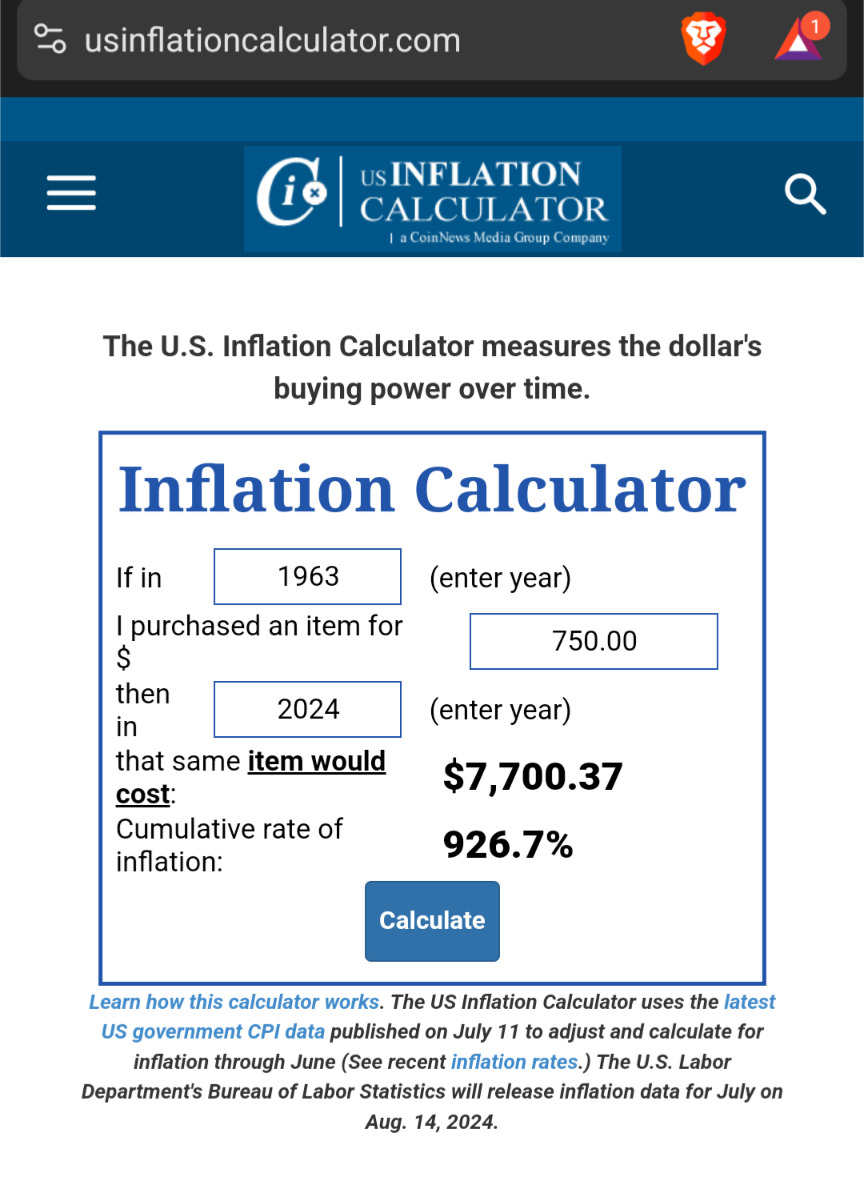Inflation is a thing. If she was born in 1946, she would have gone to college around 1964. Which means that her tuition would have been about 7600 dollars today. That’s still lower than the average in-state tuition by about 2000 dollars, but just putting that into context. However, minimum wage in 1964 was 1.15/hr, which means it would have taken about 16 weeks at full time minimum wage to pay for one semester tuition vs the 33 weeks it takes today. That’s a much better metric of comparison. It would take over a year to pay for a year of school now vs half a bit over half year before.
How does housing and food factor in too though, that’s only one portion of expenses. Entertainment costs far more for example, lots didn’t even really have entertainment than books.
Also ignores the approximately $1000 of books you’re buying every year
Entertainment costs far more for example, lots didn’t even really have entertainment than books.
This is a bizarre statement. People have had entertainment since society has been a thing. It may not always look like what you do, but it has always been around, and yes, it was more than “books”.
That average person going to school could afford and access? Books and OTA cable were the usual options, now most of that even costs money. Most actually just drank, which of course isn’t a healthy nor really an option we should factor.
The fact you think all people had to do 50 years ago was read books and drink says enough.
That was affordable and within access for most college students? I also provided other options… so clearly I don’t think those are the ONLY Options dude… for the demographic we are talking about, that’s the usual places.
I can name a few, but they all seemingly have the same alcohol theme as well.
Which demographic are you thinking we are talking about? Provide some options instead of just beaking off. You’re not adding to the discussion here. College students, probably had to rely on public transport. Not everyone is from well off families dude.
Sounds like you just have an axe to grind about alcohol.
Or people don’t realize just how prevalent drinking was to be social or entertainment back then.
I haven’t seen much options presented that don’t reside around drinking, someone suggested taking the train to another city. Thats not an option in the USA, so it sounds like people are talking about their country like it applies to the USA….
Theatre, live music events, cinema, arcades, the county fair, going to see another city
Booze, booze, booze, booze and they don’t have vehicles, so how are they getting to another city?
Most are centered around drinking while doing an activity.
None of my examples are centred around booze.
The train.
But here are even more examples: Watching a sports game (this one can involve alcohol), playing sports and games, going to the ice /roller skating rink, taking a walk/hike, having a picnic in the park, boat ride on a lake/river, frisbee, hackeysack, board games, jamming out/ making music.
Nowadays, but back when we are talking about, yeah they all centered around booze.
In NA there isn’t trains between cities dude…
Even a large portion of your new ones (other than free public) are all centered around the same main theme, drinking while hanging with friends.
What about solo entertainment? Most of your options are with other people which isn’t what people do all the time, most entertainment is solo, not with others.
A podcast I was listening to today suggested that food is more affordable now than it was 50 yo. I don’t know if that’s true, but it would seem possible given all the science lowering costs for producers (additives, artificial ingredients, preservatives).
Rent is definitely proportionally higher though, and that’s much more of the monthly budget.
I often wonder how inexpensive produce would be if GMO crops weren’t demonized. I know the USA has several varieties of GMO fruit and veg on the market, but it’s availability is so scarce, and many countries still outright ban any bioengineered organism.
do not mind the gmo crops themself. but the companies pushing them are almost nestle level horrible. open source gmo crops. now sign me up.
Costs are not the reason for higher food prices; it’s demand. They charge more because you have no option. The average person has no way or ability to grow food and not much aptitude for cooking. That’s a recipe for higher food prices.
Cost is a function of supply and demand. GMO crops yield more, so there would be a larger supply, thus driving down cost if demand remains the same. This is totally pedantic though because you’re still right:
They charge more because you have no option.
I took capitalist greed as a given… my bad.
That makes sense, due to breeding one chicken produces more product by a few factors than it used to for example.
But you would probably have to be on a specific diet to achieve it at the same time.
According to https://educationdata.org/average-cost-of-college-by-year the average tuition for a public 4 year school in 1963-1964 was $243 or just under $2500 today.
Yea, she probably went to a private university or had out of state tuition… or went to school well after 1964
Problem is I had to buy somewhere between two and five tuitions worth of education just to get one.
It should also be noted that a semester itself is about 16 weeks.
So if you worked 16 weeks full time in the summer and 32 weeks part time during your 2 semesters, you’d have 4 weeks left in the year. At absolutely minimum wage, if you lived with your parents, that’s a fairly heavy workload, but perfectly feasible to do.
Now, to pay for 2 semesters, you need to work full time for 66 weeks a year. Can you work full time while going to school? Can you manifest 8 extra weeks of full time work in a 52 week year? Can you even get a full time minimum wage job without your employer cutting hours to deny benefits?
If the boss was born in '46 this is true, but she’s a lot more likely born at the later end of boomers, since '46 would age her at 78. I’m guessing she’s at or below retirement age, not well above it
If the boomer is 60, it would only cost $2,267.87, adjusted.
If they’re 65, it would have been 3,245.61.
The numbers I got for tuition today: $41,540 at private colleges $11,260 at public colleges (in-state residents) $29,150 at public colleges (out-of-state residents)
And you could get jobs that covered your housing, food, and more easier in general
Doing the lords work here.
I just checked the university I went to. It looks like since the 50s, tuition has basically doubled every 10 years. I graduated 20 years ago, so it’s roughly 4x what I paid. So yeah, if a boomer graduated 40 years ago at $750 a semester, that would track to $12,000 a semester now. Sounds about right.
If the trend continues, she can bitch at my kids for being lazy in 10 years for not being able to work off a $24,000 a semester tuition by flipping burgers part time.
We have turned college into the biggest monetary slavery the world has ever seen. I have to believe it had something to do with prepaid college programs; it seemed to coincide with them.
When I went to college in 1980 I got grants. Free money. I wasn’t a great student, mostly B’s.
What the hell happened when they guaranteed student loans, then made bankruptcy not an option, then stopped including them in credit reports for getting loans, and stopped giving the loans responsibly so they let people over borrow who had no means to pay it back?
What happened was colleges saw the opportunity to make tons of money, guaranteed from the US GOVERNMENT, and without conscious enslaved an entire generation just when we needed them the very most.
Because this small generation is weighed down by the burden of the elderly boomers, the largest generation ever getting old, counting on the economy generated by this generation to keep them alive.
It’s sick.
If student loans were treated as normal loans (e.g. not guaranteed and absolvable via bankruptcy) we’d have boomer prices. The purpose of the student loan scam is to create debt slaves that propagate the bureaucratic managerial class.
You can say thanks to the authors of the 2005 Bankruptcy Abuse Prevention and Consumer Protection Act. Amongst them being Senator Joe Biden. A bill that he defended back in 2020 during his campaign claiming that he “improved it”.
Both Republicans and Democrats want to have slaves, Dems just provide a longer leash.
Both Republicans and Democrats want to have slaves
Welcome to the corporatocracy. Education is just another category of the service industries
Access to higher education wasn’t an issue before all these laws were put into place. People didn’t “need” a college degree like they do now. The whole policy from it’s inception was not necessary. Now college is basically a ticket to the bureaucratic white collar world that produces nothing. (e.g. bullshit jobs)
Sounds closer to my generation’s prices that boomer prices. My parents are boomers. They paid like $250/semester. Cheaper for community college.
The moment you see any dollar amount from the past you need to ask “is that adjusted for inflation” and if it isn’t you need to put it in an inflation calculator. This process needs to be second nature because otherwise you will get a very wrong idea about how much something actually cost. And post covid inflation is already skewing mental prices from just a decade ago.
I literally have a shortcut to usinflationcalculator dot com on my home screen. Because I always check for inflation. Always.
If the boomer was 60, it would still only cost $2,267.87.
If they’re 65, it would have been 3,245.61.
Tuition today: $41,540 at private colleges $11,260 at public colleges (in-state residents) $29,150 at public colleges (out-of-state residents)
Sure, inflation is a thing, but the difference in dollar amount is still staggering.
Ofc, though the problem when talking to anyone older about inflation then they’ll think that the cost just increased at the same rate as inflation. But the problem is that tuition in particular is one of the fastest rising costs that has blown through inflation many times over. By showing someone the present value of their tuition against current tuition they’ll be able to realize that it outpaced inflation and it is much less feasible to work yourself through college while working.
I feel very lucky to be in the UK. I get to go to imperial for less than the cheapest offerings in the USA.
it’s still £10k / year whereas it used to be £10k for the whole degree.
Hopefully (slim hope, but nevertheless) Labour will curtail the steady rise of fees we’ve seen in recent years. Bring back free tuition!
Yeah but i have a scholarship that covers more than tuition
This may be a stupid question, but I have been out of university for a long time. Is $11,260 for a semester?
I am considering taking a 4 credit online course at UND and the price is listed as $384.88 per credit (https://und.edu/academics/online/enroll-anytime/norw101.html , off topic, but I have finished the duolingo norwegian course and am looking for other ways to progress…)
Figuring for 12-15 credits I don’t understand where the huge number is coming from. I was also spoiled by doing half my education in the late 90’s and the other half on the GI Bill later, so I’m admittedly probably ignorant to how/where they are hitting people with extra fees and so on both then and now.
Yes, per semester. You can get away with way less if you go to a community college or online school.
Having gone to community college and a private college, the difference in class quality is great, but not over 10 times greater. Maybe three times greater? The state school classes I audited were zero to 1 times better to be honest.
The moment you see any dollar amount from the past you need to ask “is that adjusted for inflation”
Don’t forget to adjust the prevailing minimum wage for inflation while you’re at it. $750/semester while earning $7.25/hr hits much differently than $7500/semester while earning (checks notes) oh wait, it’s still $7.25/hr.
And yet, you didn’t share the result of your calculation, because it would highlight just how pointless your comment was lmao
Others had already done it. No point in reinventing the wheel.
But here you go

I went to a community college in the very early ‘90s. Tuition was $28. Parking permits were $25. Outrageous parking fees.
The next year they raised the tuition to $65.
You would not believe the outrage.
My most expensive textbook was $45. That was a huge expense when the rest were $12-$20.
Gen X here. The “good old days” lasted until the early ‘90s.
Then I went to a “real” college and got introduced to $100+ textbooks and yearly tuition that cost what a modest car would run.
State university tuition in the 90’s was about $1500 a semester. I worked a summer job for $6.50/hr and was able to earn about $1000 (before taxes) in a month. I didn’t work for the rest of the summer because I still wanted a bit of a summer break :) But it is absolutely possible back then to work a little part time, then full time in the summer to pay for college. Then you can bootstrap yourself into a career.
Right now, jobs don’t really pay any much more, but tuition is 10X or more. Unless parents pitch in, Its impossible for young people to get higher education w/o going into massive debt. I say go into trades and self-employment, it may be a better option nowadays!
https://www.in2013dollars.com/us/inflation/1960?amount=1
https://www.in2013dollars.com/us/inflation/1970?amount=1
$750 a semester in 1960 is roughly $8000 a semester today. In 1970, it’s worth roughly $6000.
A private university today costs an average of $23,000 a semester.
Easy peasy, just work three of your asses off instead of just one, and you’ll have $1,000 per semester to spare.
Well yeah, but I’ve yet to meet a boomer that doesn’t just say, “no” when you lay math like that out so
So…one text book the? lol clueless
I hope you all appreciate that Biden co-authored the bankruptcy bill that made it all possible.
Don’t forget the 1996: ANTITERRORISM AND EFFECTIVE DEATH PENALTY ACT
Out of curiosity, does anyone have a timeline of tuition prices, whether average or of a single university, from 1980s to 2020 or so?
I was able to look it up for my Canadian university, somewhat. Every year they issued the Calendar which included a section called tuitions and fees. It can be slightly complex to read depending on the degree you’re going for.
https://www.ucalgary.ca/pubs/calendar/archives/index.html
They have all the years it’s been digitally available in the link above. I suspect you could go to the campus library and find older publications to go back further.
Generally you’re looking for “Undergraduate” and “Fees”. Depending on the year it’s a PDF, or a table in html.
If you’re not used to reading it it can be painful and more complex the more recent it gets. Plus you need to sometimes know terms unique to that university.
I. E. If they say Shulich they are referring to the Engineering program. If they say Haskayne they are referring to business. Most of the other programs are referred to by proper name, I. E. Music, Law, Medicine, etc.
Most programs are 5 courses per semester though some may have you do 6 in the odd semester if you want to graduate in 4 years (alternatively you take longer, like my 4.5 years to get my B. SC, or fit them in in spring or summer)
Generally you can assume a single course is 3 units, and a single semester will be 5 courses, if the table you’re looking at is showing you the price per 3 units.
Unfortunately while the course price hasn’t gone up huge amounts (until the last few years where they tried to simplify things with categories), all those extra static fees, or extra charges for specific programs, per semester have gone up a lot.
In 2003 the general fees for say engineering were $275. 5 courses were $2190. For a total of $2465 per semester.
Divided back out that’s just under $500/course.
In 2013 general fees are $588. Courses are $2666. Engineering specific fees are $30. For a total of $3254.
Divided back out that’s about $650/course.
In 2023 the general fees are about $834. The per course rate for engineering is category D, or $908 per course. That’s $5374/semester.
Or about $1075/course.
If you are a California resident and can somehow find a way to survive in L.A. while going to college, the L.A. Community College system is surprisingly affordable itself.
Really, even out-of-state is super cheap.










